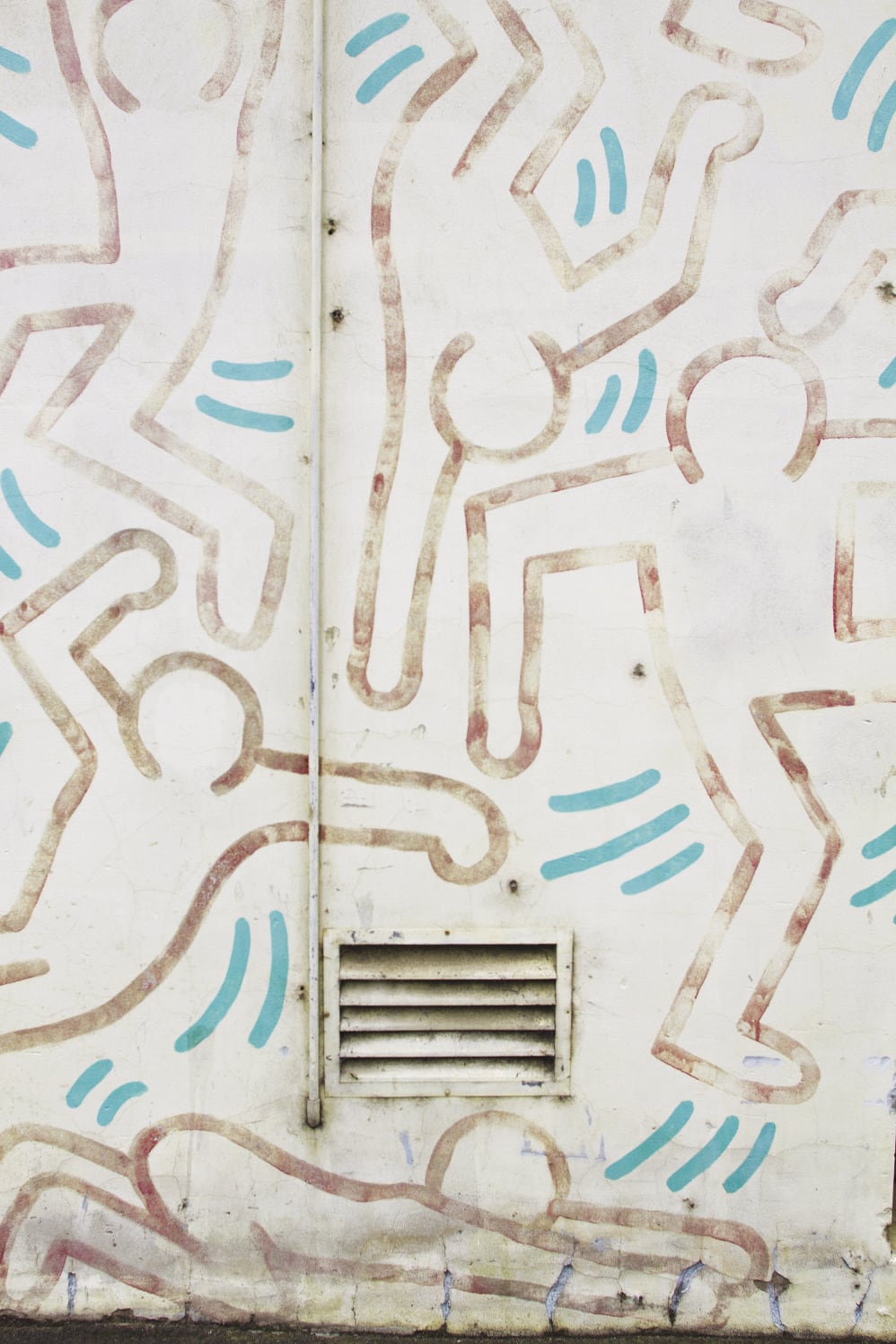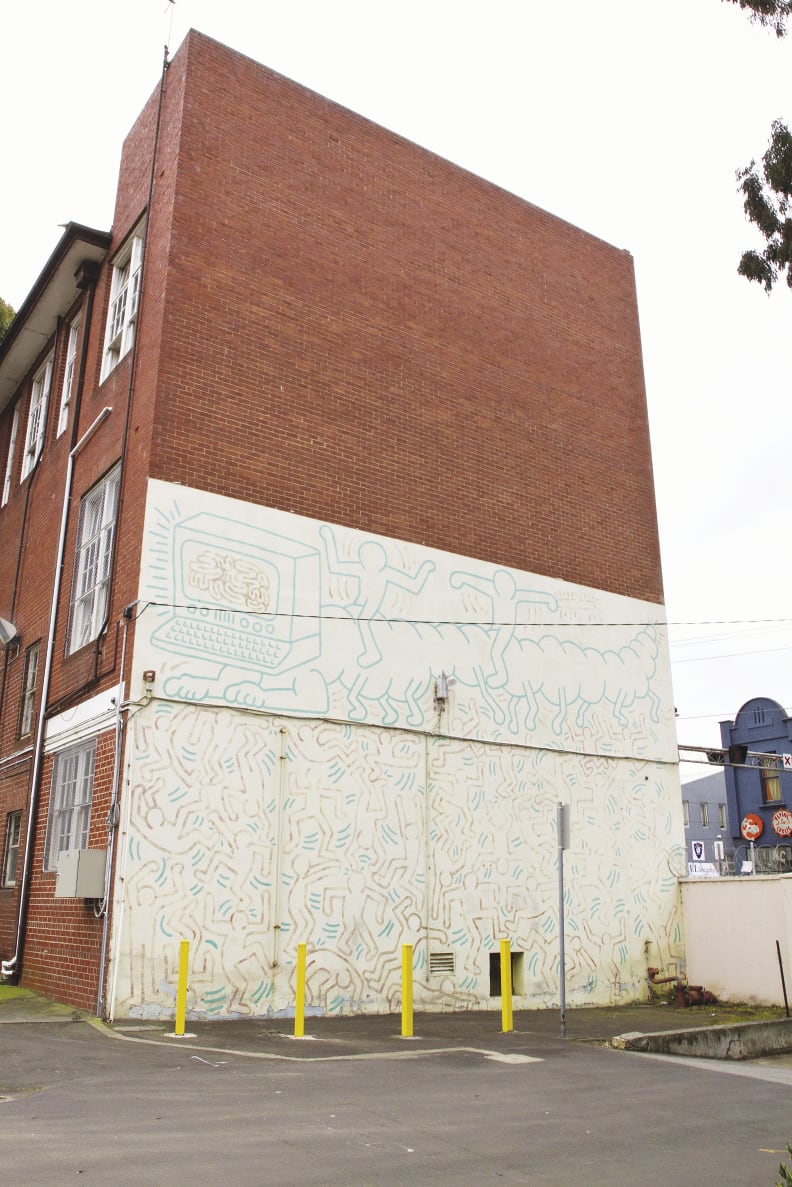
The popping curves, motion lines and electric colour scheme of Keith Haring’s (1958–1990) Untitled mural of 1984 evoke vitality and energy. But things change. Today the mural, situated at the former Collingwood Technical College, is faded and peeling in parts. Its appearance speaks of time passed by way of a surface textured with absence and, some would argue, neglect. The feeling of animated vigour in the composition has shifted to exhibit a palpable physicality and unstable tonality quite distinct from its original appearance; age has manifested as degradation or change, dependant on individual sensitivities. The work represents a unique and marginal — and therefore both valuable and vulnerable — history within its environment. Considerations for the future management of the mural — conservation, restoration or inaction — must address issues of not only how to best defend the artist’s intent for this specific work, but also facilitation of a readable historical continuum for Haring’s personal and political identities, free of didactic material. Any deciding party that advocates revision of the physical history of the mural — a scarce representative public artwork by a prominent queer-identifying artist — assumes responsibility for historical augmentation and the addition to the work of an authorial voice besides Haring’s.
The patina of the mural is typical of a work fully exposed to the elements and it exhibits the contingent realities of its environmental and architectural circumstance. After twenty-seven years, the mural has gained a complexity evolved through a self-reflexive material narrative; its extant condition is dually testament to Haring’s presence then, and absence now. In a contemporary discourse that oscillates rapidly between photographic documentation of the past and various projected potential futures, the status of the work now — as a complex plastic composition resulting from an intense, durational exhibition period — appears to have been dismissed. The paints Haring used have visibly degraded at different rates, indicating an incompatibility of materials at a chemical level. This inherently faulted materiality tells a story of spontaneity in the work, of the artist being more concerned with making the mural exist than in ensuring its longevity.

Haring conflated his identity with his art through frequent portrayal of his own queer sexuality in many non-publicly sited artworks. In an artist-activist capacity the artist worked collaboratively with AIDS awareness organisation ACT UP to combine his glyphic imagery with the mythically powerful slogans ‘Silence = Death’ and ‘Ignorance = Fear’. His work was socially engaged and deliberately connected to the times in which it was made. Haring’s responses were mobilised in reaction to the suddenly foregrounded AIDS crisis that was affecting and killing his friends and colleagues, and that would ultimately claim his own life. As an individual affected by AIDS and an artist with a need to communicate his personal politics, Haring loudly and brightly declared his position and queer identity. As a substrate, the mural platform has a similarly limited lifespan to the T-shirts, posters and badges on which Haring’s designs for ACT UP appeared. The outdoor stage has the potential to reach much greater and more various audiences than a gallery painting but pays a price for visibility through constant exposure to environmental conditions. Correspondingly, the political T-shirt is seen by many when worn but is effectively destroyed in the process. As an artist, Haring understood and actively engaged the volatile dynamics of ephemeral expression.
In ‘Aesthetics and Loss’, Edmund White notes: ‘(N)aturally, the prospect of ill-health and death or its actuality inspires a sense of urgency’.1 The physical collapse of the mural is catalyst to an aftershock of mortal panic at the prospect of losing ‘part’ of Haring that remains. In a materialist sense, the physical breakdown of the artist’s image is directly synchronised with that of the artist’s body. There is a humane instinct to ‘save’ the work from an observable, natural and continuous course of decline; an uncomfortably sincere display of degeneracy, which serves to communicate Haring’s corporeal absence. This is a para-aesthetic message, contingent to original intent; the painting wears its history. Understanding the importance of change within the work allows appreciation of the artist’s personal ephemerality.
Haring’s mural is a difficult object, embodying both an autonomous artwork and a contingent environmental artefact.2 The artist spoke of the Collingwood mural being a permanent site,3 but this was relative to his other Australian commissions, all of which were planned for obsolescence within months of completion. Given the lack of a clear statement specific to the work, extreme interventions such as over-painting or stabilisation cannot conscionably be undertaken. To allow development of the art-site under the conditions according to which it was created is to remain true and open to the difficult mortality of the work. To freeze the paint’s decay, Botox-style, would insidiously and invisibly dislocate the painting from history. To repaint would be to substitute the uncanny, glossed surface of a made-up corpse for the exposed humanity of Haring’s radiant baby. In either case, disruption to the continuity of the work’s evolution would ensure a definitive death for the mural in exchange for an indefinitely prolonged, historically irrelevant zombie future.
Andrew Atchison is a thinker, art maker and writer currently based in Melbourne.
